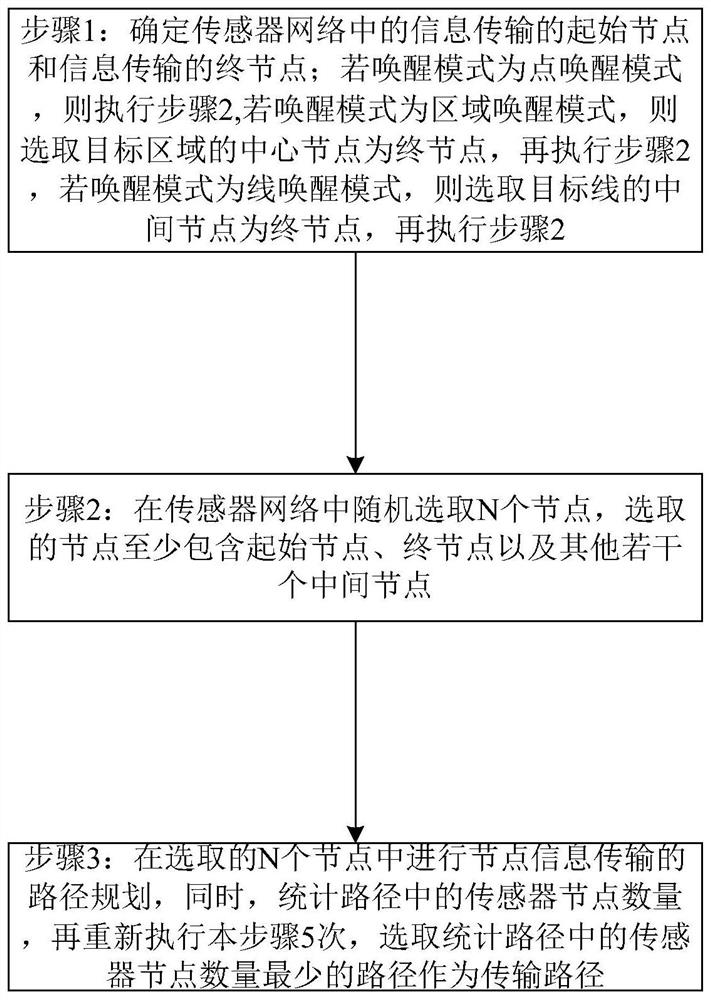Wireless sensor network node awakening system and method based on path finding algorithm
A wireless sensor network and pathfinding algorithm technology, applied in the field of wireless sensor network node wake-up system, can solve the problems of increasing the power consumption of the wireless communication system, increasing the average power consumption of nodes, redundant wakeup, etc., to achieve the reduction of pathfinding errors, The effect of reducing power consumption and reducing the probability of false wake-up
- Summary
- Abstract
- Description
- Claims
- Application Information
AI Technical Summary
Problems solved by technology
Method used
Image
Examples
Embodiment 1
[0030] like figure 1 As shown, the wireless sensor network node wake-up system based on the pathfinding algorithm includes: an active wake-up center, a wireless sensor node and a sensor network; the wireless sensor nodes are irregularly distributed in the sensor network; the wireless sensor nodes include : a central control unit, an active wake-up control unit, a passive wake-up control unit and a sensor; the active wake-up control unit responds to a wake-up command from an active wake-up center to wake up sensor nodes; the passive wake-up control unit presets a trigger in the central control unit Under the control of conditions, the sensor node is awakened; the active wake-up center includes: a wake-up mode selection unit, a pathfinding unit and an execution unit; the wake-up mode selection unit provides three wake-up mode options; the three wake-up modes are respectively : Area wake-up mode, linear wake-up mode and point wake-up mode; the pathfinding unit, based on the wake-...
Embodiment 2
[0033] On the basis of the previous embodiment, the process of establishing the pathfinding model performs the following steps: establishing a pathfinding map based on wireless sensor nodes and sensor networks, specifically referred to as: abstracting the sensor network into a connection line, and abstracting the wireless sensor network into The nodes are abstracted into points, and the sensor nodes are numbered at the same time. The address numbers of all sensor nodes are different; based on the established pathfinding map, a genetic pathfinding model is established. The genetic pathfinding model adjusts the preset Set the parameters in the pathfinding model to generate a pathfinding path.
[0034] Specifically, refer to Figure 5 , this process can be understood as treating the wireless sensor nodes and the sensor network as a whole map. On this map, consider sensor nodes as path nodes and sensor networks as connected networks.
Embodiment 3
[0036] On the basis of the previous embodiment, the method for performing pathfinding with the genetic pathfinding model performs the following steps: Step 1: Determine the starting node of information transmission and the end node of information transmission in the sensor network; if the wake-up mode is point In wake-up mode, execute step 2. If the wake-up mode is area wake-up mode, select the central node of the target area as the end node, and then perform step 2. If the wake-up mode is line wake-up mode, select the middle node of the target line as the end node , and then execute step 2; step 2: randomly select N nodes in the sensor network, the selected nodes include at least the start node, end node and several other intermediate nodes; step 3: perform node information in the selected N nodes For transmission path planning, at the same time, count the number of sensor nodes in the path, and then repeat this step 5 times, and select the path with the least number of sensor...
PUM
 Login to View More
Login to View More Abstract
Description
Claims
Application Information
 Login to View More
Login to View More - Generate Ideas
- Intellectual Property
- Life Sciences
- Materials
- Tech Scout
- Unparalleled Data Quality
- Higher Quality Content
- 60% Fewer Hallucinations
Browse by: Latest US Patents, China's latest patents, Technical Efficacy Thesaurus, Application Domain, Technology Topic, Popular Technical Reports.
© 2025 PatSnap. All rights reserved.Legal|Privacy policy|Modern Slavery Act Transparency Statement|Sitemap|About US| Contact US: help@patsnap.com



